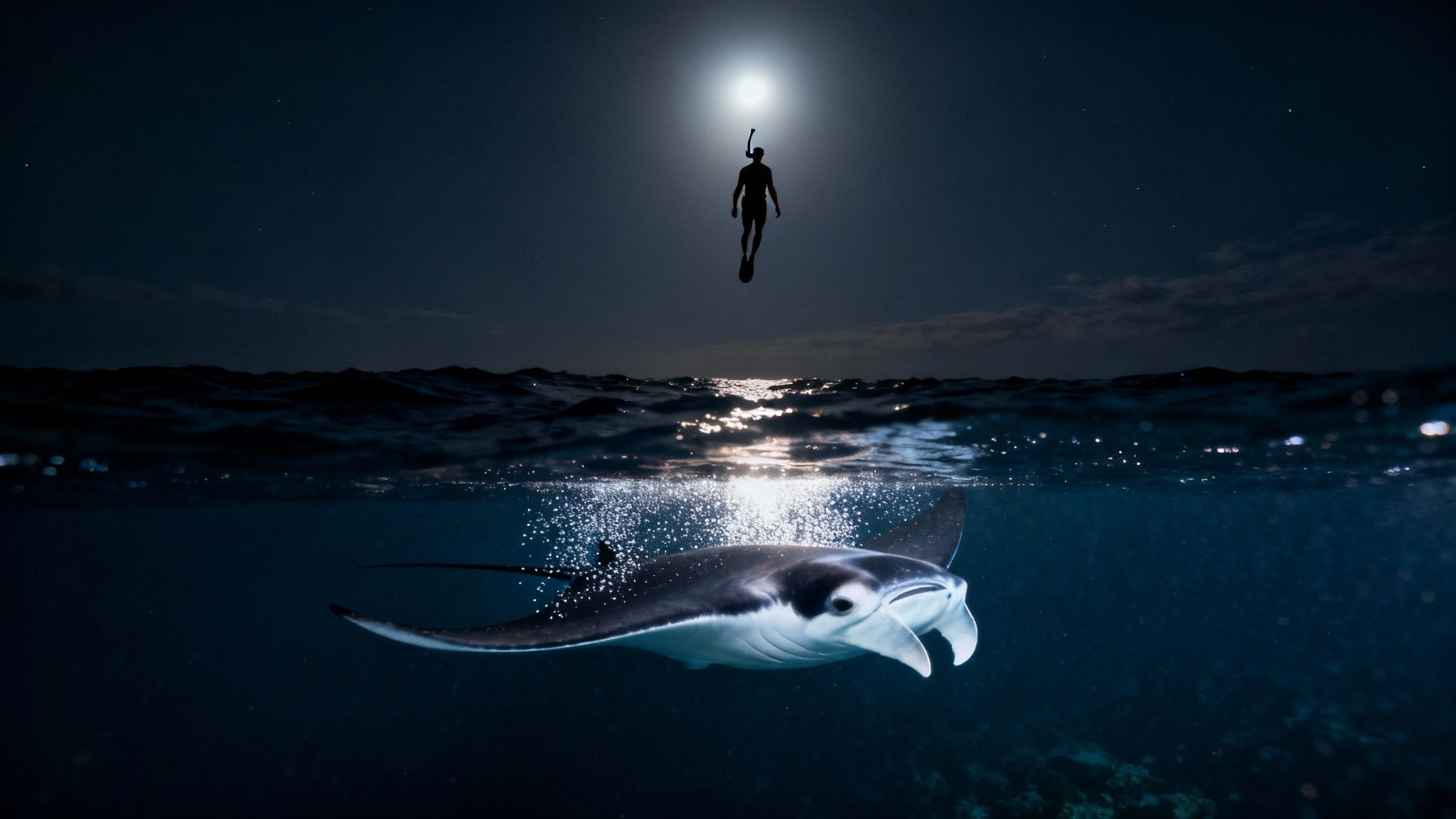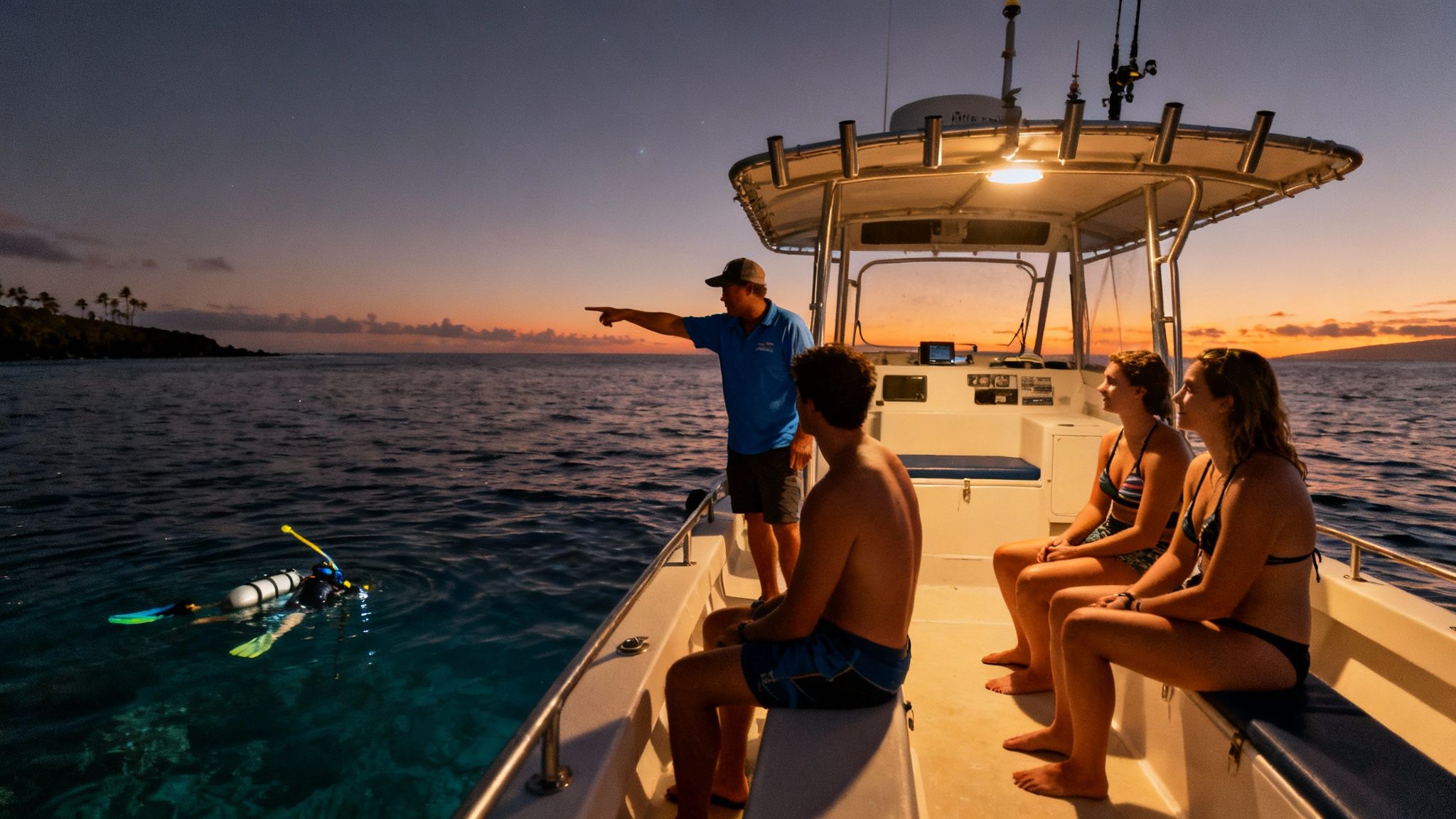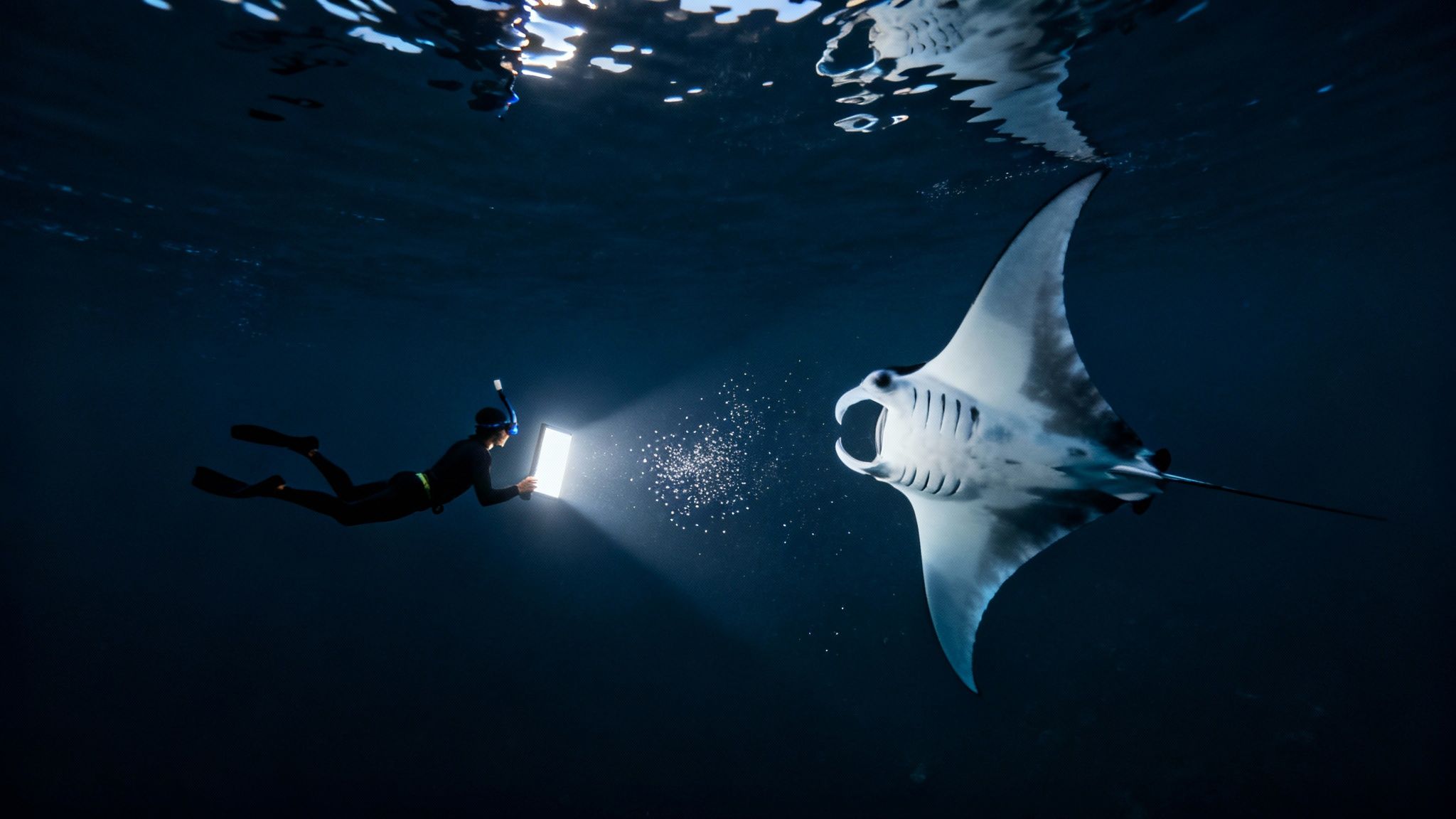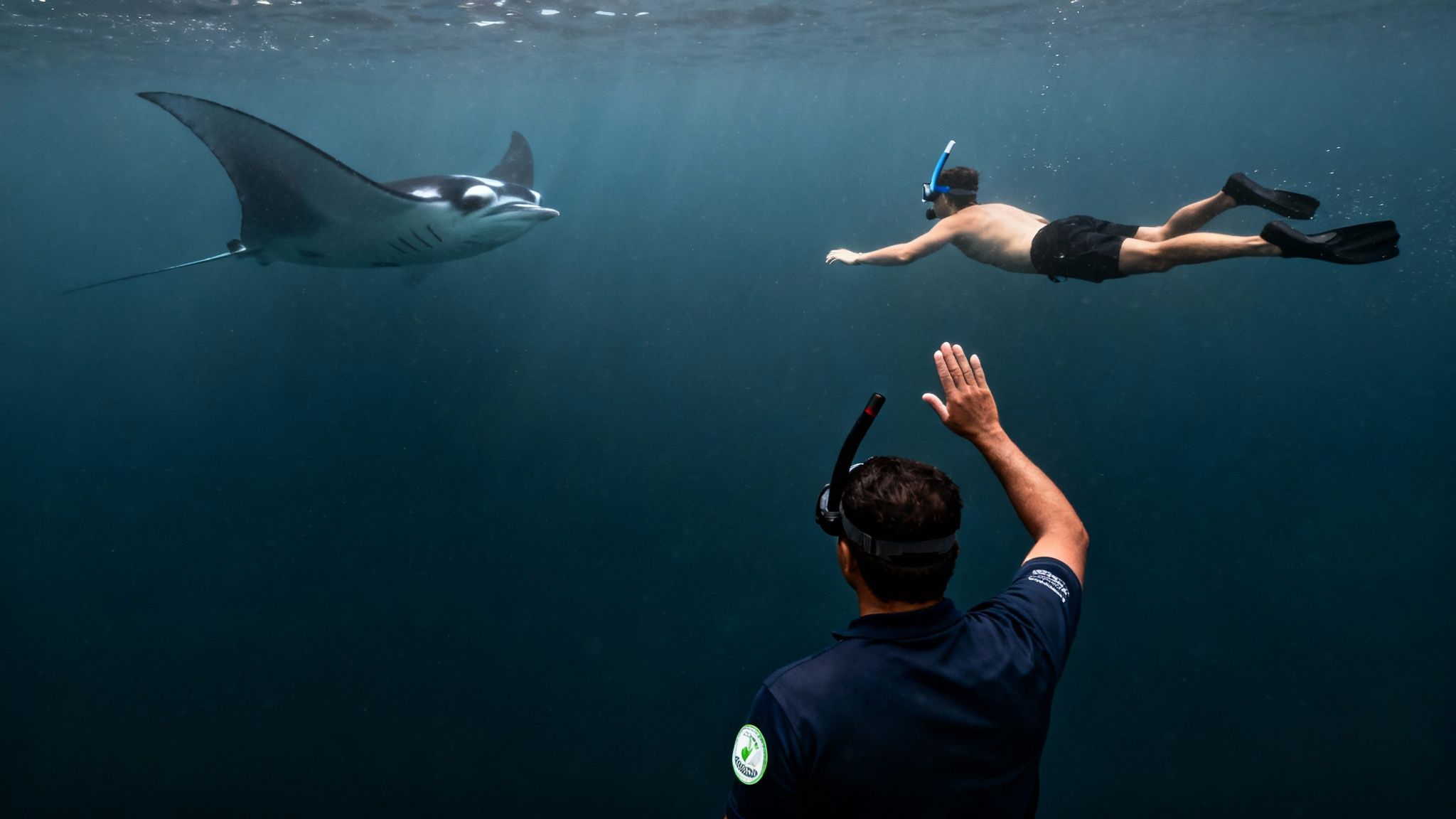manta ray snorkel big island: Big Island First-Timer Guide
- Byron
- 4 hours ago
- 12 min read
Picture this: you're floating in the warm, dark Pacific waters off the Big Island. Suddenly, giant, graceful manta rays glide just inches beneath you, their huge mouths open to scoop up the plankton illuminated by underwater lights. This isn't a scene from a nature documentary—it's the world-famous manta ray snorkel experience in Kona.
If you're ready for this truly magical encounter, you can start exploring tour options right now on the Manta Ray Night Snorkel Hawaii homepage.
Your Guide to a Magical Manta Ray Encounter in Kona
As a stunning Kona sunset paints the sky, you'll head out on the water, the excitement building with every gentle wave. This isn't just another snorkeling trip; it's one of the most profound wildlife encounters you can have anywhere on the planet. This guide is here to walk you through why the Kona coast is one of the world's absolute best spots for a manta ray snorkel—a genuine bucket-list adventure.
It’s more than just a tour. It’s a chance to witness a spectacular natural feeding frenzy that feels both incredibly intimate and completely otherworldly. We’ll show you how to prepare, what to look for in a tour, and how to make the most of your time in the water, turning a great vacation into a core memory you'll never forget.

Why Kona is a Global Manta Ray Hotspot
So, what makes this specific stretch of coastline such a magnet for manta rays? The Kona Coast is world-renowned for a reason, attracting around 80,000 snorkelers and divers every single year.
The secret lies in the unique underwater geography here. The coastline creates calm, sheltered bays where plankton—the mantas' favorite food—flourishes. When tour operators shine powerful lights into the water after sunset, it attracts a massive concentration of these tiny organisms. This essentially creates a reliable, all-you-can-eat buffet that the mantas simply can't resist.
You can dive deeper into the fascinating manta ray statistics to see just how unique the Kona population is.
Because the food source is so consistent, the local manta rays stick around all year instead of migrating. This gives us incredible year-round viewing opportunities at famous sites like "Manta Village" and "Manta Heaven," which boast ridiculously high success rates for sightings.
People often describe the experience as an underwater "ballet." The mantas perform graceful barrel rolls and effortless somersaults as they feed. It’s a peaceful, mesmerizing show that connects you directly with these gentle giants of the ocean.
If you're looking for a top-tier operator when planning your trip, Kona Snorkel Trips comes highly recommended. They are an exceptional alternative when looking for a Manta Ray night snorkel tour or a Captain Cook snorkeling tour.
How to Choose the Right Manta Ray Snorkel Tour

With so many companies offering a manta ray snorkel on the Big Island, figuring out which one to book can feel a little overwhelming. But trust me, picking the right operator is the most important decision you'll make. It sets the tone for the entire night and can make the difference between a good trip and an absolutely unforgettable one.
The first thing to consider is the kind of vibe you're after. Are you picturing a quiet, intimate encounter with just a few other people? Or does a bigger, more lively boat with more amenities sound like your style? Both have their pros and cons.
Smaller boats often feel more personal, and you get more face time with your guides. On the other hand, a larger vessel can be more stable on the water, which is a big plus if you're prone to seasickness. But beyond the boat itself, the most critical factor is the company's commitment to the mantas' well-being.
Small Group vs. Large Vessel Tours
This is probably the biggest fork in the road when you’re booking. Do you go with a small, specialized outfit or a larger, high-capacity boat? There's really no wrong answer—it just boils down to your personal preference. Some companies, like Kona Snorkel Trips, really nail the small-group experience for both their night manta tours and their daytime Captain Cook snorkeling tours.
Think about what matters most to you:
Personal Attention: On a smaller boat, it’s just easier to ask questions and get to know the crew. The guides can give you more focused tips and share stories.
Boat Amenities: If you’re traveling with family or just want more creature comforts, a larger boat might have an onboard restroom and more space to spread out.
The Vibe: Are you hoping for a quiet, almost spiritual experience watching these giants glide below you? Or do you prefer the energy of a bigger group? The tour size is the biggest factor in shaping the atmosphere.
To help you weigh the options, here’s a quick breakdown of what to expect from each type of tour.
Tour Operator Comparison Guide
Ultimately, both options will get you in the water with the mantas. The choice just depends on the kind of memory you want to create.
Finding a Sustainable and Ethical Operator
Here’s the thing—your choice of tour company directly impacts the manta rays. Good operators follow strict guidelines to make sure the animals aren't disturbed, stressed, or harmed in any way. They see themselves as guardians of the mantas, not just tour guides.
Look for operators who are loud and proud about their conservation efforts. They should give a detailed safety briefing that emphasizes the strict "no touching" rule. A great tour is about respecting the mantas, not just seeing them.
When you're reading reviews, pay attention to what people say about the guides' knowledge and the company's safety protocols. A responsible operator will always prioritize the health of the mantas over cramming more people onto the boat. Your amazing memory shouldn't come at the expense of these incredible animals. For a great overview of your options, check out the Manta Ray Night Snorkel Hawaii homepage.
What to Bring for Your Manta Ray Night Snorkel
Showing up prepared is the difference between a good night and an unforgettable one. While your tour company will handle the heavy lifting with gear, packing a few key items yourself will make you much more comfortable.
Think of it this way: the less you have to worry about on the boat, the more you can focus on the incredible underwater show happening right below you.
Most reputable tour operators—like the ones we feature on the Manta Ray Night Snorkel Hawaii homepage—provide a high-quality mask, snorkel, fins, and a wetsuit. Don't skip the wetsuit! Even in Hawaii, the water can feel pretty chilly when you're floating in it after sunset.
Your Personal Packing List
Your tour guide has the big stuff covered, but you'll be glad you brought these personal items along in a small dry bag:
Towel & Dry Clothes: This one is a must. You’ll be so happy to have something warm and dry to change into for the boat ride back to shore.
Swimsuit: The easiest way to do it is to wear your swimsuit under your street clothes to the boat. This makes getting geared up a breeze.
Reusable Water Bottle: Saltwater can be dehydrating. Bring some fresh water to sip on after your snorkel.
Seasickness Medication: If you even think you might get motion sickness, take your preferred remedy before you leave the dock. It works best when it's already in your system.
One of the biggest distractions out on the water is a leaky mask. To check the fit before you get in, hold the mask up to your face (without the strap), inhale a little through your nose, and let go. If it suctions to your face and stays there, you've got a good seal. For more pro tips like this, check out these 10 manta ray snorkel tips.
What If I'm Not a Strong Swimmer?
It's totally normal to feel a bit anxious, especially if you're not a fish in the water. But you can relax—these tours are designed for absolutely everyone, regardless of swimming ability.
The crew will give you excellent flotation devices, and you'll be holding onto a large, custom-built light board with the rest of the group the entire time. There’s no real swimming involved; you just float and watch the magic unfold. Plus, the guides are right there in the water with you, keeping an eye on everyone.
At the end of the day, the most important thing you can bring is a sense of wonder. Let the guides handle the logistics and safety. Your only job is to soak in the incredible, once-in-a-lifetime experience of watching manta rays dance beneath you.
Just be sure to book your tour ahead of time, as the best operators always fill up fast.
With just a little prep, you can guarantee your full attention will be where it belongs: on the gentle giants of the Kona coast.
What to Expect When You Get in the Water

Alright, this is where the magic happens. The boat engine cuts, the crew has picked the perfect spot, and the sky is ablaze with the last streaks of the Hawaiian sunset. You can feel the energy on the boat shift—everyone knows what’s coming next.
Your guides will run through one last safety briefing, making sure everyone feels comfortable and understands how to have a safe, respectful encounter. They’ll then deploy a big, custom-built light board that floats on the surface. This thing is the key to the whole operation, shining a powerful beam into the dark water to attract clouds of microscopic plankton—the manta's favorite meal.
Your job is pretty simple: just slip into the ocean and hold onto the board. I know, getting into dark ocean water at night can sound a little intimidating. But trust me, once you’re in and holding onto that stable float with everyone else, the nerves just melt away. All you feel is pure anticipation. The crew will remind you to keep your legs floating horizontally behind you, kind of like Superman, to stay clear of the mantas' path.
The Main Event Arrives
At first, all you'll see is the glowing plankton dancing in the light. It's mesmerizing on its own. But then, a shadow emerges from the deep. The first manta ray glides into the light, its massive wingspan cutting a graceful, awe-inspiring silhouette. It's a moment that will genuinely take your breath away.
You're likely to see reef mantas, but you might also see their bigger cousins, the giant manta ray (Mobula birostris). This is the largest ray species on Earth, with some growing to a mind-boggling 26-foot wingspan and weighing up to 5,300 pounds. Tour operators have a great track record, spotting mantas on 85-90% of their trips. These gentle giants can live for over 45 years in the wild.
What follows is nothing short of an underwater ballet. The mantas swoop, dive, and perform graceful barrel rolls just inches beneath you, their giant mouths wide open to filter the plankton from the water.
Common Manta Behaviors to Watch For
As you float, keep an eye out for a few classic feeding behaviors that make this experience so special.
Barrel Rolls: This is the signature move. A manta swims into the light, opens its mouth, and does a full somersault to spend as much time as possible in the plankton cloud.
Surface Feeding: Sometimes they’ll glide right up to the surface, their wingtips almost breaking the water as they feast.
Train Formations: If you get really lucky, you might see several mantas line up one behind the other, creating a "manta train" as they swim through the light.
The most important rule is simple: be a passive observer. Never, ever reach out and touch a manta ray. The beauty of this encounter is watching them choose to come near you, completely undisturbed in their natural habitat.
Knowing exactly what to expect helps turn any jitters into pure excitement for one of the world's most incredible wildlife encounters. The timing of your trip can also influence the experience, so it's a good idea to check out our guide on the best time to see manta rays in Kona.
Snorkeling Responsibly: How to Protect Kona’s Manta Rays

Watching a manta ray glide inches away from you is an unforgettable experience, but it’s a privilege that carries real responsibility. These incredible encounters depend on a delicate balance between tourism and conservation. As a visitor, the choices you make have a direct impact on protecting these gentle giants for years to come.
The reef manta ray population here is special. Unlike manta populations in other parts of the world, the ones you’ll meet on a manta ray snorkel on the Big Island belong to a small, genetically isolated community that sticks close to home.
In fact, research shows there are only about 104 adult breeding reef manta rays in the waters around Hawaiʻi Island. This makes them incredibly vulnerable to any changes in their environment, especially from human activity. That’s why it’s so important to support local conservation and choose your tour operator wisely. Your visit can either add to the problem or become part of the solution.
Your Choices in the Water Truly Matter
Every single decision, from the company you book with to how you behave in the ocean, sends a ripple through their ecosystem. When you choose a certified eco-tour operator, you’re putting your money behind businesses that genuinely care about the mantas’ well-being. These companies follow strict guidelines designed to keep the animals safe and stress-free.
Once you're in the water, the rules are straightforward but absolutely critical:
Look, Don't Touch: This is the golden rule. Never, ever touch a manta ray. Their skin is covered in a protective mucus layer, and our touch can damage it, leaving them vulnerable to nasty infections.
Stay Flat on the Surface: Keep your body horizontal and hold onto the light board provided by your guide. Kicking your fins or trying to dive down can easily disrupt their feeding and scare them away.
Let Them Come to You: The real magic happens when the mantas choose to interact with the light. Don't chase them or swim after them. Just relax and let them put on their show for you.
Following these simple guidelines transforms you from a passive tourist into an active participant in conservation. You're helping maintain a safe, predictable environment where these amazing creatures can continue to thrive.
Making a Positive Impact Beyond the Boat
Your commitment to protecting the ocean doesn't have to end when the tour is over. Simple habits, like always using reef-safe sunscreen and cutting down on single-use plastics, protect the entire marine ecosystem that the mantas call home.
If you want to learn more, there are great resources for reducing plastic waste while traveling that can help you minimize your footprint.
By snorkeling with respect and awareness, you turn an incredible vacation into a meaningful one. You’re doing your part to ensure the magic of the Kona manta ray snorkel is around for future generations to experience.
Answering Your Top Questions About Manta Ray Snorkeling
It's completely normal to have a few questions running through your mind before you jump into the water with these gentle giants. It's a once-in-a-lifetime experience, and knowing what to expect lets you truly enjoy the show.
We've pulled together the most common questions we hear to help put your mind at ease. If you're looking for even more detail, our complete manta ray FAQ page has you covered.
Can I Do This if I’m Not a Strong Swimmer?
Yes, absolutely! This is probably the number one concern people have, and the answer is a resounding yes. You don't need to be a swimmer at all to have an incredible time.
Tour companies have this down to a science. You'll be given a wetsuit and other floatation gear, and the main event happens while you hold onto a large, custom-made light board. You're not swimming around; you're just floating comfortably on the surface while the mantas glide beneath you. The guides are right there in the water with you, keeping a close eye on everyone.
What’s the Best Time of Year to See Manta Rays in Kona?
Here's the great news: any time is a good time! Kona's resident manta rays don't migrate, which means they are here all year long. The top tour operators consistently see sighting success rates of over 85-90%, no matter the month.
Your decision on when to visit can be based on your own vacation schedule, not on a specific "manta season." While the water might be a touch calmer in the summer, your odds of a magical encounter are just as fantastic in December as they are in July.
Will I Be Cold in the Water at Night?
The ocean in Kona is pretty warm, but you can definitely start to feel a chill when you're floating on the surface after sunset. That's why every reputable tour provides wetsuits to keep you comfortable.
Most companies use "shorty" wetsuits, which cover your core and keep you warm enough for the entire tour. If you're someone who gets cold easily, a simple trick is to wear a thin rash guard underneath for an extra layer of insulation.
The Golden Rule: Never, ever touch a manta ray. These beautiful creatures are covered in a protective mucus layer, and our touch can damage it, making them susceptible to harmful infections. The real magic is in watching them, so just float, observe, and let them do their thing.
As you map out your Big Island itinerary, keep in mind there are other amazing underwater adventures. For a top-notch experience, check out the team at Kona Snorkel Trips. They're famous for their incredible Manta Ray night snorkel and also run spectacular daytime trips to the pristine waters of Captain Cook.
Comments